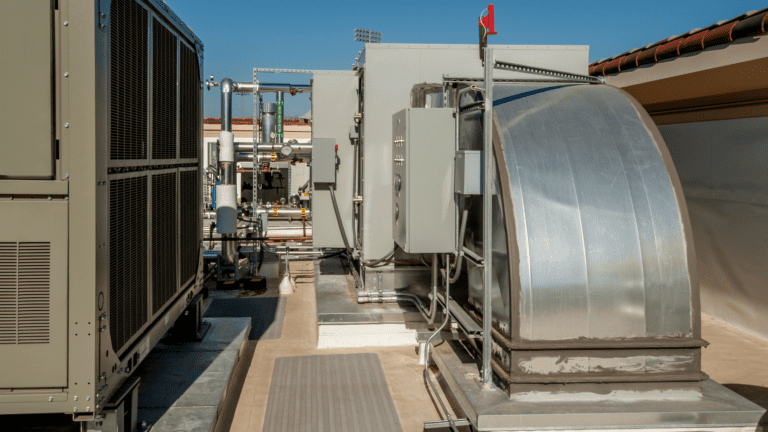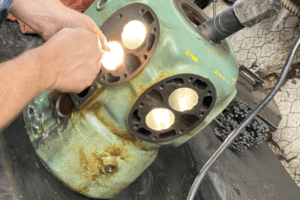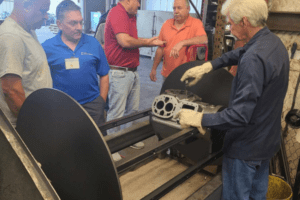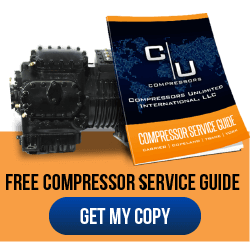

As you can probably guess, that part is the compressor.
It’s true the compressor is the “heart” of the HVAC and does the most work. However, we caution you to remember many system problems don’t originate in the compressor. When you suffer early compressor failure, it often means there is another problem that has gone unnoticed.
The key parts of the commercial HVAC system include:
1. Air Conditioner
The air conditioner in a commercial HVAC system is very similar to a residential unit. Its purpose is to dehumidify the air and remove heat. It is important to remember that the air conditioner itself does not cool the building, but works with many other subsystems to regulate the temperature.
2. Compressor
A compressor, like an Carrier/Carlyle 06ET275360, is the key to the cooling cycle and kicks off the main “loop” that enables you to manage temperatures. It compresses the refrigerant, raising its temperature. The refrigerant is then passed on to the condenser, where the cooling process can start in earnest.
3. Condenser
The condenser is the heat exchanger that serves as the hot side of the air conditioning unit. It removes heat from the building and transfers it to the exterior. Gas refrigerant then becomes liquid refrigerant. A heat pump can also have a condenser, in which case it functions to collect heat from the outside.
4. Thermal Expansion Valve
The expansion valve is an essential part of the condenser’s function. It removes pressure from the liquid refrigerant so expansion can take place, turning the substance from a liquid into a vapor. The expansion valve provides for precise flow control of refrigerant into the evaporator coil.
High-pressure liquid refrigerant is very warm at the time it first enters the expansion valve, so a precision valve improves overall system efficiency. The thermal expansion valve can be on either the inside or the outside of the air handler, screwed in front of the evaporator coil or brazed into the copper lines that link up to the air handler.
5. Air Handler (including Evaporator Coil and Blower)
The air handler is the component responsible for circulating air through the system. In most structures, it is connected directly to the ductwork. It blows cooled or heated air into the building and then returns it back into the system. It includes a blower, heating and cooling elements, and a variety of other devices.
Of all the different parts of the air handler, the evaporator coil is the one most likely to need maintenance or replacement. The evaporator coil holds chilled refrigerant received from the compressor. As air from the blower fan moves over the coil, heat is removed from the air in the treated area.
6. Terminal Units
Terminal units consist of an air filter, coil, and blower. Size varies significantly. The most common terminal units in a commercial HVAC are the mid-sized rooftop units (RTUs) in contrast to the largest make-up air units (MTUs). They can be used to control temperatures in a single room.
7. Chiller
Chillers come in air-cooled and water-cooled varieties. Their function is to remove heat from the liquid that courses through the structure’s pipes. In an air-cooled chiller, the condenser coils are cooled by fan-driven air, with the unit usually found outdoors.
Systems that sustain intense cooling for long periods of time are more likely to use water-cooled chillers. These are chilled by water that undergoes a constant recirculation process. As it circulates, warm water is carried away and cool water enters from an exterior cooling tower.
8. Duct System
You probably won’t see the duct system itself referenced on a list of HVAC parts in many articles. Ducts can be very old and may even predate your current HVAC system. However, they should not be overlooked as an essential part of system performance, as they distribute air all throughout your building.
For the rest of your HVAC system to work, your ductwork must be clean and intact.
In old buildings, narrow ducts that don’t conform to modern HVAC standards can become clogged without notice. Cleaning the ducts annually can help you extend the service life of other components. Don’t forget to clean or replace filters according to the manufacturer instructions for your filter type.
The processes that make a commercial HVAC work are complex. The key to keeping the system running is regular maintenance, taking into account all components and the operating environment. If you’ve been getting unreliable performance or you’re just not sure your system is optimized, ask yourself: Is Your HVAC Compressor Working at 100% Capacity?












